Margot Note's Blog, page 41
April 17, 2018
Letter #24: More Than Ever in Love with You
I'm continuing my series of scanning, transcribing, and annotating my grandfather's love letters to my grandmother leading up to their marriage in June 1940. The letters are chronologically organized and preserved, using the methods I discuss in detail in my book, Creating Family Archives: How to Preserve Your Papers and Photographs.
In the 24th letter in the Grandpa's Love Letter series, Grandpa dashes off a few lines before going out to a movie.
Grandpa's looking for a new place to move into with my grandmother when they get married. He hadn't mentioned that Grandma visited Scranton before, so perhaps the trip with her friend Veronica would be her first. When I knew her, Grandma seemed to keep to herself, so it's nice to see that she has a friend that she feels comfortable to travel with.
[image error]
Written on the back: "Ann Warren Oct. 31, 1937"
I love this picture of her from three years before this letter was written. She Americanized her name from the Lithuanian "Anna Varasinkas" to "Ann Warren."

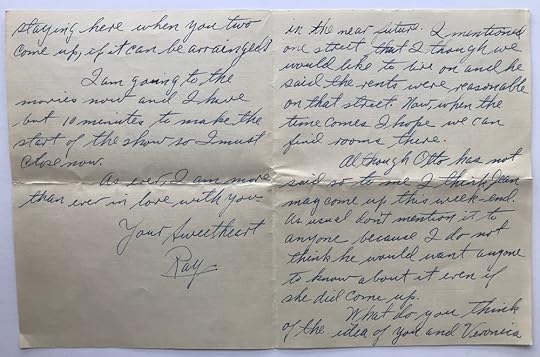
***
Scranton Pa
4/17/40
Dear Ann:
We did not reach the shop until 9.45 on Monday. We tried to avoid a bad detour but some how or other took the wrong road and ended up near Wilkes Barre which is 18 miles from Scranton.
I do not think I will be home this coming weekend as Otto does not intend to go home and perhaps Fred his cousin will stay over for the first time.
I mentioned to Mr. Kretch that I would be looking for rooms in earnest in the near future. I mentioned one street that I though [sic] we would like to live on and he said the rens were reasonable on that street. Now, when the time comes I hope we can find rooms there.
Although Otto has not said so to me I think Jean may come up this week-end. As usua don't mention it to anyone because I do not think he would want anyone to know about it even if she did come up.
What do you think of the idea of you and Veronica staying here when you two come up, if it can be arrainged [sid]?
I am going to the movies now and I have but 10 minutes to make the start of the show so I must close now.
As ever, I am more than ever in love with you.
Your Sweetheart
Ray
***
Creating Family Archives: How to Preserve Your Papers and Photographs
By Margot Note
If you like archives, memory, and legacy as much as I do, you might consider signing up for my email list. Every few weeks I send out a newsletter with new articles and exclusive content for readers. It’s basically my way of keeping in touch with you and letting you know what’s going on. Your information is protected and I never spam.
Ready to get started creating your family archives? Here are some of my favorite products:
Follow me on Pinterest | Instagram | Twitter | LinkedIn | Facebook

April 16, 2018
A Quick Guide to Writing Abstracts
An abstract is a summary of the work reported in a paper. It allows readers to quickly identify articles of interest to them, without having to read the whole document. Together with the title, the abstract is also used by databases to allow articles to be searched easily.
Abstracts should almost always be written last. It should briefly state the overall thesis and scope of the paper, describe the methodology employed, summarize the results, and reiterate the main findings. Most journals specify a word limit, which is less than 250 words.
Often when writing professionally, you will have to supply your own abstract. Even if you are writing a paper that will never be published, writing an abstract can help you solidify and summarize the ideas described in your paper.
When writing your abstract, never include information or conclusions that are not given in the paper. The abstract should be understandable by itself, as it will be published separately in abstracting services. The abstract should not contain abbreviations and references to literature and to figures and tables.
It may also be helpful to add a keyword list at the end of your abstract, which will be used by indexing and abstracting services. Consider adding keywords not already in the title or the abstract, so that readers find it easier to locate your paper.
Follow me on Pinterest | Instagram | Twitter | LinkedIn |
Like this post? Never miss an update when you sign up for my newsletter:

April 10, 2018
Letter #23: When We Go Honeymooning
I'm continuing my series of scanning, transcribing, and annotating my grandfather's love letters to my grandmother leading up to their marriage in June 1940. The letters are chronologically organized and preserved, using the methods I discuss in detail in my book, Creating Family Archives: How to Preserve Your Papers and Photographs.
In the 23rd letter of the Grandpa's Love Letters series, Grandpa has had it! He's decided that the overtime he put in during the previous weekend wasn't worth it, as he had even more work on Monday. (Years before Sheryl Sandberg's ridiculous idea of "leaning in," Grandpa realized that leaning in will only make you exhausted!)
Some questions: What happened to Tony? What card was brought to the library? What stamps did Grandpa want?
We learn in this letter that Otto is getting married in May, and Grandpa is preparing for his honeymoon by getting a driver's license.
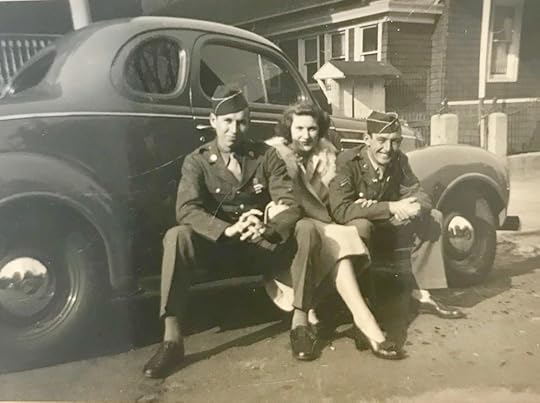
An undated photograph with Bob, Ann, and Charles
I found this photograph from the mid-forties. It features Bob Zabit (Grandma's stepbrother), Grandma (Ann), and Charles Note. Charles died in battle in the Philippines. My father was named after him. Did Grandpa take this picture?
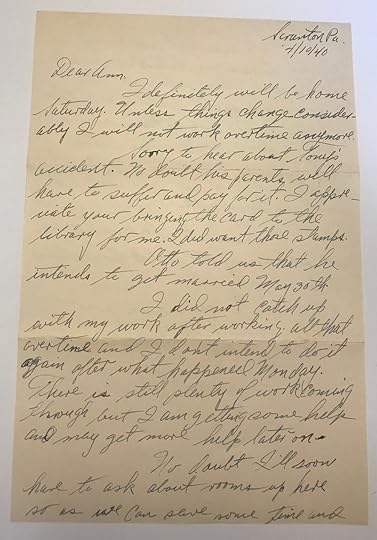
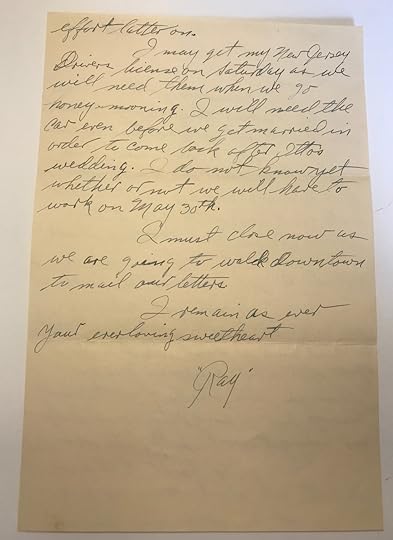
***
Scranton Pa
4/10/40
Dear Ann
I definitely will be home Saturday. Unless things change considerably I will not work overtime anymore.
Sorry to hear about Tony's accident. No doubt his parents will have to suffer and pay for it. I appreciate your bringing the card to the library for me. I did want those stamps.
Otto told us that he intends to get married May 30th.
I did not catch up with my work after working all that overline and I don't intend to do it again after what happened Monday. There is still plenty of work coming through but I am getting some help and may get more help later on.
No doubt I'll soon have to ask about rooms up here so as we can save some time and effort latter [sic] on.
I may get my New Jersey Drivers license on Saturday as we will need them when we go honeymooning. I will need the car even before we get married in order to come back after Otto's wedding. I do not know yet whether or not we will have to work on May 30th.
I must close now as we are going to walk downtown to mail our letters.
I remain as ever your everloving sweetheart
:"Ray"
***
Creating Family Archives: How to Preserve Your Papers and Photographs
By Margot Note
If you like archives, memory, and legacy as much as I do, you might consider signing up for my email list. Every few weeks I send out a newsletter with new articles and exclusive content for readers. It’s basically my way of keeping in touch with you and letting you know what’s going on. Your information is protected and I never spam.
Ready to get started creating your family archives? Here are some of my favorite products:
Follow me on Pinterest | Instagram | Twitter | LinkedIn | Facebook

April 9, 2018
An Interview on The Life Story Coach Podcast
I was recently interviewed on The Life Story Coach podcast about my book, Creating Family Archives: How to Preserve Your Papers and Photographs.
Hosted by Amy Woods Butler, a personal historian and life story writer, The Life Story Coach podcast helps listeners build careers as professional writers of personal and family histories.
Here's the blurb for Episode 9:
Are your clients drowning in years' worth of photos, papers, and other family history mementos? Learn tips on how to help them get their archives in order the way the professionals do it. Archivist Margot Note has 19 years of experience in working with organizations and individuals.
The wonderfully written show notes are worth a read.
To learn the preservation secrets used by libraries, archives, and museums to protect their priceless materials (that you can also use for your family heritage items) read my book:
Creating Family Archives: How to Preserve Your Papers and Photographs
By Margot Note
Like this post? Never miss an update when you sign up for my newsletter:
Ready to get started creating your family archives? Here are some of my favorite products:
Follow me on Pinterest | Instagram | Twitter | LinkedIn | Facebook
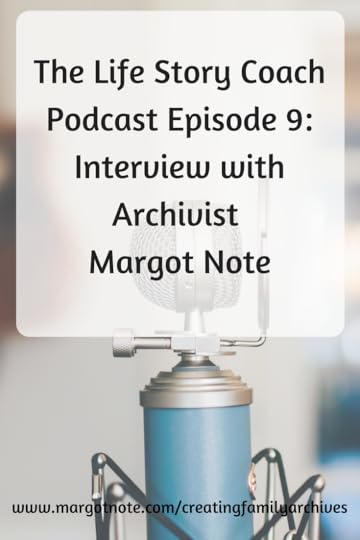
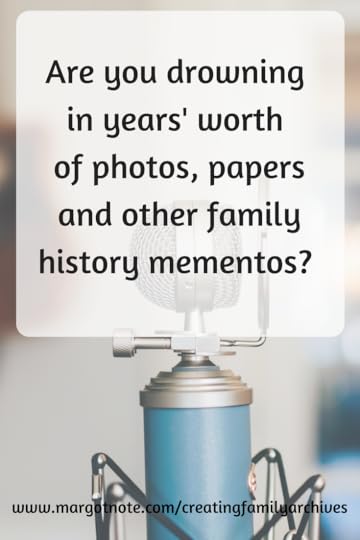

April 6, 2018
Letter #22: A Mighty Effort
I'm continuing my series of scanning, transcribing, and annotating my grandfather's love letters to my grandmother leading up to their marriage in June 1940. The letters are chronologically organized and preserved, using the methods I discuss in detail in my book, Creating Family Archives: How to Preserve Your Papers and Photographs.
In the 22nd letter of the Grandpa's Love Letters series, Grandpa talks about catching up with his work. He also realizes that working so hard is not sustainable. Part of his work involves filling out tickets related to piece work for clothing, which I imagine is tedious.
I was surprised by the part in which the superintendent (who seems to be the equivalent of a foreman) says that perhaps Grandpa can have a week off for his honeymoon in June if he can train someone to do his job. I'm trying not to use presentism (the tendency to interpret past events in terms of modern values and concepts) to interpret this comment. Was the superintendent as big as a jerk as he sounds, or was this a common response?

The back of this photo reads: Apr. 1935, Tidal Basin. Cherry Trees
I thought this picture was appropriate for spring. Grandpa and a friend are posed at the Tidal Basin, a partially man-made reservoir between the Potomac River and the Washington Channel in Washington, D.C. The basin is part of West Potomac Park and is a focal point of the National Cherry Blossom Festival held each spring. Did Grandma take this picture? Her handwriting is on the back of the photo.

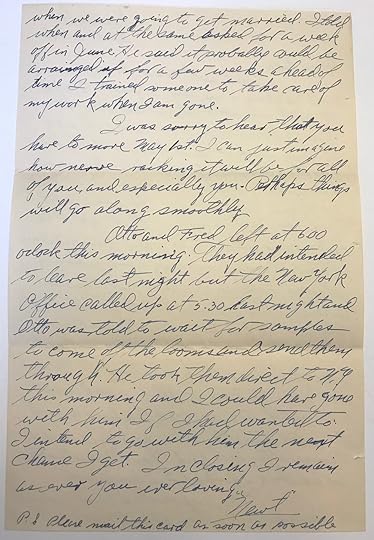
***
Scranton Pa.
April 6, 1940
Dear Ann
I did not come home because I am making a mighty effort to catch u with my work. I worked straight through from 8.15 to 4.45 today and may do some work at home today and tomorrow besides going in for awhile tomorrow morning. If I should catch up with my work and then end up the same way again on next Friday I will not work as hard again under the same conditions. Starting Monday morning I am going to get some help in making out the piece tickets which requires a lot of detail work that anyone can do without much knowledge but a lot of time. I got my desk in from Paterson which I intend to clean out etc. tomorrow. All I need some is an outlet for my desk lamp and a rack for piece tickets with a rack for rubber stamps attached and then I'll be all set so far as desk equipment is concerned.
The superintend [sic] came around on Thursday and asked about you and when we were going to get married. I told when and at the same [time] asked for a week off in June. He said it probably could be arranged if for a few weeks ahead of time I trained someone to take care of my work when I am gone.
I was sorry to hear that you have to move May 1st. I can just imagine how nerve racking it will be for all of you, and especially you. Perhaps things will go along smoothly.
Otto and Fred left at 6.00 oclock this morning. They had intended to leave last night but the New York Office called up at 5.30 last night and Otto was told to wait for samples to come off the looms and send them through. He took them direct to N.Y. this morning and I could have gone with him If I had wanted to. I intend to go with him the next chance I get.
In closing I remain as ever you [sic] ever loving,
:"Newt"
P.S. Please mail this card as soon as possible.
***
Creating Family Archives: How to Preserve Your Papers and Photographs
By Margot Note
If you like archives, memory, and legacy as much as I do, you might consider signing up for my email list. Every few weeks I send out a newsletter with new articles and exclusive content for readers. It’s basically my way of keeping in touch with you and letting you know what’s going on. Your information is protected and I never spam.
Ready to get started creating your family archives? Here are some of my favorite products:
Follow me on Pinterest | Instagram | Twitter | LinkedIn | Facebook
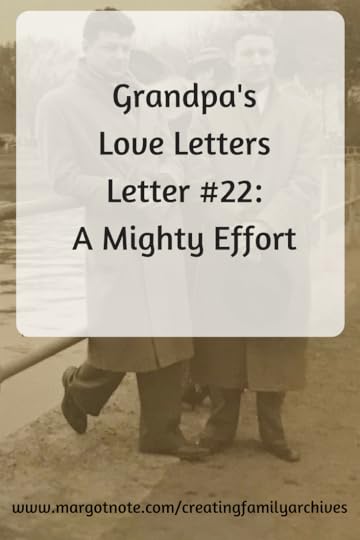
April 2, 2018
Letter #21: The Flood of 1940
I'm continuing my series of scanning, transcribing, and annotating my grandfather's love letters to my grandmother leading up to their marriage in June 1940. The letters are chronologically organized and preserved, using the methods I discuss in detail in my book, Creating Family Archives: How to Preserve Your Papers and Photographs.
In the 21st letter of the Grandpa's Love Letters series, Grandpa buries the headline! The first part of the letter discusses work: working through the weekend to get caught up, dining with his supervisor (which he had written about before), and a friend moving to Scranton.
The second part was about the historic flood of April 1940 in Pennsylvania, which caused damage, death, and explosions. As you may remember, I had written previously about the Valentine's Day blizzard. Nineteen forty must have been quite the year for weather!
A New York Times article from April 1, 1940. reports:
A huge gasoline explosion and fire gave the Wilkes-Barre area an arresting spectacle today, the third day of the battle to hold in check the floodwaters of the raging Susquehanna....
This break [of a dike] caused the flooding of the area in which, several hours later, the tanks of the American Oil Company exploded and burned....
The explosion let off with a roar that was heard up and down the valley. There arose a burst of flame at least a hundred feet high, and in its wake came a rush of black smoke, which was visible as far as twenty miles away.
A section of the levee broke, buildings and homes were destroyed, and about 25,000 people were left homeless. Here's a video I found with pictures from the local newspaper:
The last paragraphs of his letter discusses the flood and its impact on Scranton.
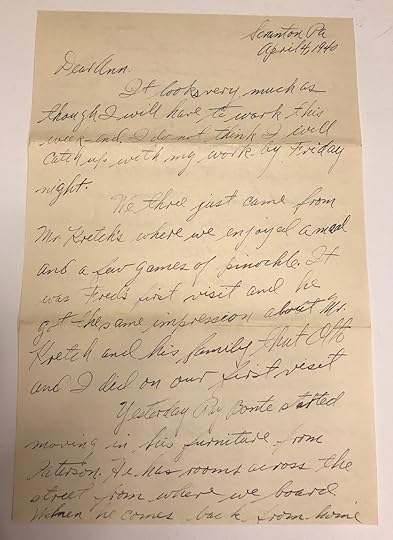
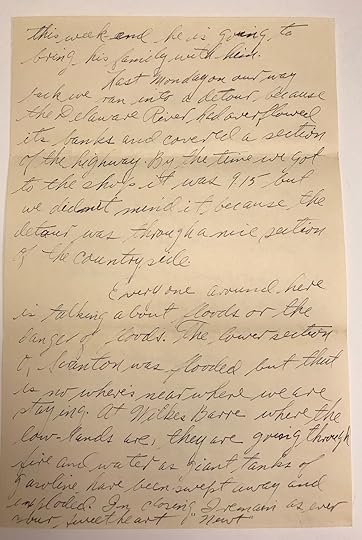
***
Scranton Pa
April 4, 1940
Dear Ann
It looks very much as though I will have to work this week-end. I do not think I will catch up with my work by Friday night.
We three just came from Mr. Kretch's where we enjoyed a meal and a few games of pinochle. It was Fred's first visit and he got the same impression about Mr. Kretch and his family that Otto and I did on our first visit.
Yesterday Ray Bonte started moving in his furniture from Paterson. He has rooms across the street from where we board. When he comes back from home this week-end he is going to bring his family with him.
Last Monday on our way back we ran into a detour because the Delaware River had overflowed its banks and covered a section of the highway. By the time we got to the shop it was 9.15 but we didn't mind it because the detour was through a nice section of the countryside.
Everyone around here is talking about floods or the danger of floods. The lower section of Scranton was flooded but that is no where's [sic] near where we are staying. At Wilkes Barre where the low-lands are, they are going through fire and water as giant tanks of gasoline have been swept away and exploded. In closing, I remain as ever your sweetheart "Newt"
***
To learn the preservation secrets used by libraries, archives, and museums to protect their priceless materials (that you can also use for your family heritage items), read my book:
Creating Family Archives: How to Preserve Your Papers and Photographs
By Margot Note
If you like archives, memory, and legacy as much as I do, you might consider signing up for my email list. Every few weeks I send out a newsletter with new articles and exclusive content for readers. It’s basically my way of keeping in touch with you and letting you know what’s going on. Your information is protected and I never spam.
Ready to get started creating your family archives? Here are some of my favorite products:
Follow me on Pinterest | Instagram | Twitter | LinkedIn | Facebook
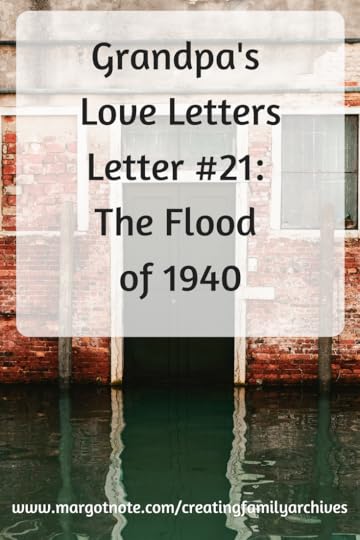
Digital Project Considerations
Over the years, I've directed or have been part of a number of digitization projects. With each new experience, I've gathered a series of questions, an aide-mémoire, to be explored before commencing a digitization initiative.
By asking these projects during the planning phase of your project, you save an incredible amount of time, money, and effort later on. Make sure that you and your team, as well as the executive sponsors and stakeholders of the project, are in agreement about these elements.
These questions explore issues related to image-based collections, but you can easily apply them to other types of collections too.
AudienceWho is the intended audience?Are they specialists, general users, or both?What are the needs of the users, and how can they be best served?What will digitization enable them to do that is not possible with analog images?SelectionDo the images reflect the institutional mission and collections policies?What is the intellectual value of such images and their informational content?What are the images that are most valuable for teaching and scholarship?What images are used most frequently, and how are they used?What images are unique to the institution?Do the images have sufficient intrinsic value to ensure interest in their digital surrogates?Will digitization significantly enhance access or increase use by an identifiable constituency?How much of the collection is well documented?What images are of highest monetary value?What images are judged to be at highest risk and why?Are there any restricted or sensitive images to be excluded?Are the images well captioned?Will the proposed scanning technique be able to capture the appearance of the item accurately?Will disparate collections be unified?Are the images duplicated well elsewhere?Do the images selected accurate represent the collection’s strengths?Is there a danger of over- or under-representing specific themes?Physical Characteristics of CollectionsHow many items have to be digitized?What are the formats of the collection?What is the physical condition of the images?How do the originals need to be handled during scanning to prevent damage?Will the images be able to withstand handling during the scanning process?What size are the images? Are they oversized?Intellectual Property Rights and Legal and Cultural ConsiderationsWho will be responsible for evaluating the copyright status of selected images?Who owns the rights to the images?Are they in the public domain? If not, can permissions be secured?Are there legal or cultural considerations to be addressed?Are the images free from donor restrictions that would prevent them from being digitized or publicly accessed?FundingWho will be responsible for fundraising and grant writing?What are the funding sources? Who will manage budgets?What parts of the project will funding support?Are the costs in line with the anticipated value?Are the costs of scanning and post-scan processing supportable?What will it cost to maintain access into the future?TechnologyIs there sufficient technical infrastructure to create, manage, and deliver digital projects?Does current technology yield image quality adequate to meet project goals?What hardware is required to meet digitization needs?What software is required to meet digitization needs?Are there sufficient storage facilities to meet digitization needs?Project PlanningWhat will be the short-term, immediate benefits of the project?What are the long-term, strategic benefits of the project?What are the expected outcomes of the project?What is the intended workflow of the project?StaffingDoes the institution have the necessary expertise and resources to plan and implement the project?What skills, experience, or training will be required for each activity?Who will oversee digitization initiatives?What kind of staff are needed, and what will their responsibilities be?What institutional support and leadership can they expect?How will digitization affect staff roles and service at the institution?Are staff levels and available skills appropriate to support the growing size and scope of the collections and access to these images by users?Who will be responsible for each stage of digitization?Who will write project documentation and progress reports?PreparationWill images be conserved before being scanned?Will it be necessary to clean images prior to scanning?Will images need to be encapsulated or de-encapsulated prior to scanning?Will images need to be transported before digitization?DigitizationWill the digitizing take place in-house or through a vendor?What are the resolutions and bit depths needed?Will the files be compressed?Should the images be faithful reproductions or optimized for presentation?How will copies of the images be stored?Are there specific image guidelines specified by the funding source?Will master and derivative files be created?Quality AssessmentIs digitization complete? Are images missing?Have the file naming conventions been adhered to?Are the files named for the correct original images?Have the images been captured in the correct mode (color or grayscale)? Are the images in the correct format and, if appropriate, are the compression rates correct?Are the resolutions and bit depths correct?Are the tonal values and color balances correct?Are the brightness and contrast settings correct?Is there noticeable interference, noise, or artifacts?Does the image accurately represent the qualities of the original?Have the significant details been successfully reproduced?Have the images been checked on a variety of monitors?If printing is required, have the images been output to a variety of printers?Description and MetadataWho uses the images and how do they request photographs?What are the most frequently requested subjects?What type of description already exists for the collection?At what level will the metadata be: item, collection, or both?Is there sufficient metadata available to match perceived user needs and project aims?What metadata or finding aid scheme will be used?If there are several versions of an original, which version will be cataloged?Is it possible to create metadata that satisfies both general and specialized users?What level of granularity will most likely benefit users?Are there other fields necessary as access points that might be of interest to users?Will extensive research time be required to record even the minimal metadata requirements?Is there enough information readily available about the images to provide a useful context to potential audiences?AccessWill the images be linked to existing systems, or will it be necessary to develop a new access method for the images?At what level will access be provided: item, collection, or both?Will the images be accessible and deliverable online?How will users locate the collections, items within the collections, and relevant subsets of the items?How will images be viewed? One at a time or several together to facilitate comparisons?Will zooming be required?Will access be appropriately controlled?TimeframeWhat are the critical deadlines?How long will each component of the project take?What are the anticipated start and end dates?Does the timeframe include the possibility of delays?Collaboration and OutreachWill the project have a collaborative component?Is the collaboration local, national, or international?Is there a community outreach component?What will the instruction and end-user support be?Content Management Systems What new opportunities is the CMS intended to create?How will institutional buy-in be ensured?What is the cost-benefit ratio?What is the anticipated impact of the CMS on organizational thinking about and use of digital content? How will the CMS technology be integrated into existing systems?What metadata will be required to support the application of CMS technology?EvaluationHow will evaluation of the digital resources be undertaken?What measures exist to demonstrate the project has succeeded?How will user perceptions and expectations of the project be addressed?SustainabilityHow and where will be the archival images be stored?What kind of backup mechanisms are in place in case of hardware or software failure?What are the data migration and refreshment plans?Is there demonstrable long-term support in place to maintain the project and ensure its longevity in the future?
Like this post? Never miss an update when you sign up for my newsletter:
Follow me on Pinterest | Instagram | Twitter | LinkedIn | Facebook
March 27, 2018
Letter #20: Belgian Circle Banquet
I'm continuing my series of scanning, transcribing, and annotating my grandfather's love letters to my grandmother leading up to their marriage in June 1940. The letters are chronologically organized and preserved, using the methods I discuss in detail in my book, Creating Family Archives: How to Preserve Your Papers and Photographs.
In the 20th letter of the Grandpa's Love Letters series, Grandpa talks about work and mentions his stamp collection. In previous letters, he had written a few notes for Joe, Grandma's stepbrother, who also collected stamps. I had heard growing up that the stamp collection was stolen because I don't remember seeing it in person.
Grandpa mentions ten cent commemorative stamps of authors and poets. I was able to find online some examples of that series, which were printed in February 1940. Samuel L. Clemens (Mark Twain) and James Whitcomb Riley were included.
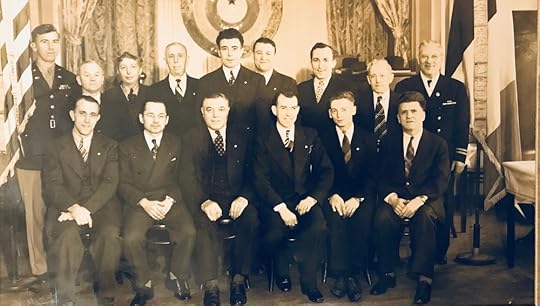
The Belgian Circle of Paterson, New Jersey from the 1950s. Grandpa's in the back row, center, next to the guy who looks like Albert Camus.
In a previous letter, I mentioned the Belgian Circle. My great-grandfather was on the board, as well as my grandfather. Mostly, it was a social group centered around drinking, according to my uncle. I always feel conflicted about writing about the Belgian Circle of Paterson because of the history of alcoholism and addiction in my family. I imagine many people working with their family history may feel this way too. Addiction can go back for generations, and I am thankful and proud that I've broken the cycle.
Two things that strike me about this letter: Grandpa seems to be randomly capitalizing the letter "I" and he used his birth name--Rene--for the first time in his letters. He must have been feeling very Belgian at the moment!
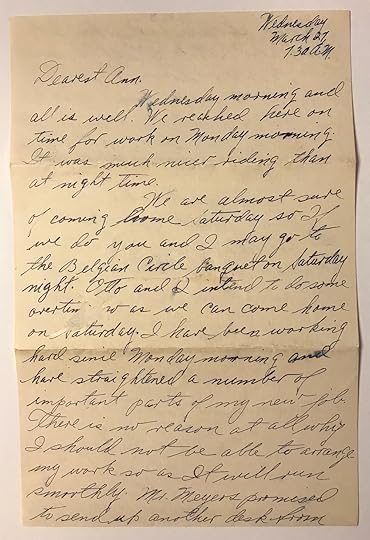

***
Wednesday
March 27
7.30 A.M.
Dearest Ann,
Wednesday morning and all is well. We reached here on time for work on Monday morning. It was much nicer riding than at night time.
We are almost sure of coming home Saturday so If we do you and I may go to the Belgian Circle banquet on Saturday night. Otto and I intend to do some overtime so as we can come home on Saturday. I have been working hard since Monday morning and have straightened a number of important parts of my new job. There is no reason at all why I should not be able to arrange my work so as It will run smoothly. Mr. Meyers promised to send up another desk from Paterson for me and when It comes in I'll be all set. I would like to stay on this job until I get it to run like a clock and then I would not mind at all making another change for the better.
Otto just asked me If I dreamt about you last and am telling you about my dream in this letter. He also just told me it has started to snow.
I must close now as breakfast will be ready soon.
With all my love
I remain your lover.
Very truly yours
"Rene"
P.S. Tell Joe I have two 10 cent stamps of the new issues of poets and Writers.
***
To learn the preservation secrets used by libraries, archives, and museums to protect their priceless materials (that you can also use for your family heritage items), read my book:
Creating Family Archives: How to Preserve Your Papers and Photographs
By Margot Note
If you like archives, memory, and legacy as much as I do, you might consider signing up for my email list. Every few weeks I send out a newsletter with new articles and exclusive content for readers. It’s basically my way of keeping in touch with you and letting you know what’s going on. Your information is protected and I never spam.
Ready to get started creating your family archives? Here are some of my favorite products:
Follow me on Pinterest | Instagram | Twitter | LinkedIn | Facebook

March 26, 2018
Call for Panelists: When Bad Things Happen to Good Librarians
I'm excited to serve on SLA's Emergency Preparedness & Recovery Advisory Council (EPRAC). I've included our call for panelists below. Do you know anyone interested in sharing their stories with fellow information professionals? If you have any questions, please leave comments or email me at margot@margotnote.com.
When Bad Things Happen to Good Librarians
Has your library been affected by a fire, flood, earthquake, or hurricane? Threatened by an active shooter or civil disturbance? Served as a shelter in a storm? Emergencies like these can not only bring library services to a grinding halt—they can also destroy collections, compromise critical technology, and even endanger employees and patrons.
Nobody understands the scope and severity of such challenges like people who have experienced them. If you’ve experienced a disaster or emergency situation in your library, please consider sharing it with your fellow librarians at SLA 2018.
The SLA Emergency Preparedness & Recovery Advisory Council (EPRAC) is sponsoring a panel presentation, “In the Eye of the Storm: Librarians Share Their Emergency Lessons,” on Tuesday, June 12. The session will last one hour, and panelists will have 10-12 minutes apiece to share their insights into planning for emergencies, responding during the midst of crises, and recovering from disruption and loss.
If you’re interested in sharing your emergency experiences, please contact Stuart Hales at SLA headquarters at (703) 647-4900 or shales@sla.org.
Like this post? Never miss an update when you sign up for my newsletter:
Follow me on Pinterest | Instagram | Twitter | LinkedIn | Facebook
March 19, 2018
Catching Up
The great part of getting your personal and family archives organized is that you can immediately access and use your materials to learn about your own history. Once I was able to organize my materials, using techniques discussed Creating Family Archives: How to Preserve Your Papers and Photographs, I could research my relatives much easier. The tips I outline in my upcoming webinar, Organize What's Meaningful to You, allowed me to get started on this ambitious project without getting overwhelmed.
This January, I started a project of scanning, transcribing, and annotating my grandfather's love letters to my grandmother leading up to their marriage in June 1940. The letters are chronologically organized and posted in real-time so you can follow their courtship as it happened. I've also been using the letters to help me decode their photographs, and searching through my photograph collection to decipher some of the details included in the letters.
I wondered if I was the only one interested about reading these letters! My own interest in my history was enough to keep me excited, but I pondered if it was worth the effort to create each post. Recently, I was spending a Sunday afternoon working on these letters, thinking these thoughts, when I received the following email. Glen, the writer, has allowed me to share this note, with identifying information removed:
I've just found your website today by accident. I have been trying to think about ways to write my own family history and the histories of others in a more systematic way and my searching brought me here.
I have read some of your posts featuring Ray's letters to Ann. He writes with beautiful economy, has the kind of precision about small details (costs, time taken traveling) that feature in some of my letters and includes such tender comments to Anne. He's very sweet but he doesn't gush; I like that.
I have some love letters, written in 1922, that [redacted] (who became my grandpa) wrote to [redacted] (whom he married in 1926). You make a comment about how Ray's letters to Ann show you a perspective on your grandparents that you never had. That is exactly how I feel. [Redacted's] letters are like a time machine, taking me back to a time and place that I could never otherwise experience, and it feels like a great privilege to be in possession of them. When I knew them, as a child, they were in their 60s and 70s. Grandpa seemed a bit dour and scary to us. He was not unkind, he just seemed taciturn and a bit severe, because I think he was shy and introverted. These letters, however, are the grandpa I never knew. They reveal a dutiful son, a sensitive young man, a conscientious employee and a dotting suitor.
Thanks so much for all your thoughtful content and for sharing both the family stories but also your thoughts on approaching letters, photographs and documents in a considered and analytical way, and in being grateful for them. They are treasures and it is good to remind myself that they are so.
Want to learn more? Join me to learn how to Organize What's Meaningful to You.
Catch up on Grandpa's Love Letters so far:
To learn the preservation secrets used by libraries, archives, and museums to protect their priceless materials (that you can also use for your family heritage items), read my book:
Creating Family Archives: How to Preserve Your Papers and Photographs
By Margot Note
If you like archives, memory, and legacy as much as I do, you might consider signing up for my email list. Every few weeks I send out a newsletter with new articles and exclusive content for readers. It’s basically my way of keeping in touch with you and letting you know what’s going on. Your information is protected and I never spam.
Ready to get started creating your family archives? Here are some of my favorite products:
Follow me on Pinterest | Instagram | Twitter | LinkedIn | Facebook



